copyright 2002, 1979 Margaret L. Benner All rights reserved.
In order to understand pronoun – antecedent agreement, you must first understand pronouns.
A pronoun is a word used to stand for (or take the place of) a noun.
Below are the personal pronouns. They are called “personal” because they usually refer to persons (except for it, which refers to things).
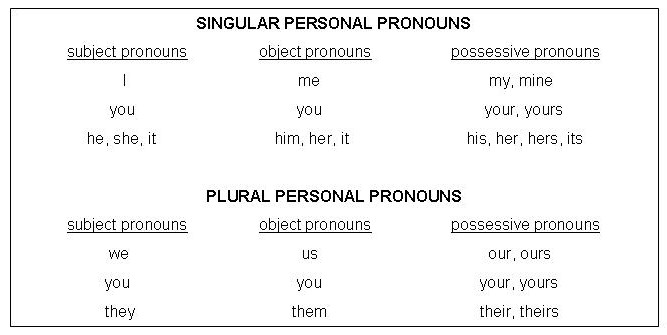
Look at this sentence.

There are two nouns in this sentence: John and man.
Either of these nouns can be replaced by a pronoun. If we replace John (the subject of the sentence) with a pronoun, we choose he, a subject pronoun.
![]()
If we replace man (the object in the sentence) with a pronoun, we choose him, an object pronoun.
![]()
For you to do:
Rewrite the following sentence in the space provided, first replacing the subject noun Laura with a subject pronoun; then replacing the object noun Amy with an object pronoun.
These sample sentences tell us some important things about pronouns:
1. A pronoun takes the place of a noun.
2. The pronoun which replaces the noun must agree with it in these ways:
a) A subject pronoun must replace a subject noun.
An object pronoun must replace an object noun.
b) A feminine pronoun must replace a feminine noun.
A masculine pronoun must replace a masculine noun.
c) A singular pronoun must replace a singular noun.
A plural pronoun must replace a plural noun.
Thus, in the sentence
![]()
We must replace the singular, masculine subject noun, John, with the singular, masculine subject pronoun, He. We can replace the singular, feminine object noun, woman, with singular, feminine object pronoun, her.
Here is another problem for you to solve.
Three words describe the properties of of the pronoun he. Select the correct ones, then click on "submit" and check your answers.
A pronoun can also refer to an earlier noun or pronoun in the sentence.
Look at this sentence.

We do not talk or write this way. Automatically, we replace the noun Lincoln’s with a pronoun. More naturally, we say

The pronoun his refers to President Lincoln.
In this sentence, the pronoun his is called the REFERENT because it “refers back.”
We call President Lincoln the ANTECEDENT because it comes before the pronoun that refers to it later. (ante = “before”)
Thus, the mechanics of the sentence look like this:
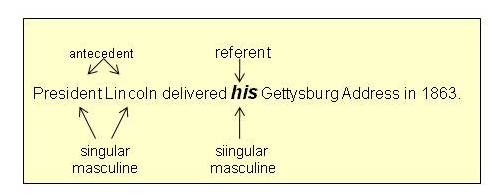
Look at the examples below to see how to choose the right pronoun for two antecedents joined by and, or, or nor.
1. When two or more singular noun antecedents are joined by and, they make a PLURAL antecedent. (1 + 1 = 2)
example:
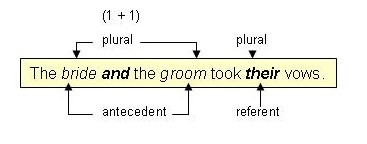
NOTE: The plural pronoun their replaces both masculine and feminine nouns.
If both noun antecedents joined by and are plural, then the referent pronoun will also be PLURAL.

2. When two or more noun antecedents are joined by or or nor, choose a pronoun referent to agree with the antecedent CLOSEST TO THE VERB.
Examples:
A. Two singular antecedents

B. Two plural antecedents

C. One singular antecedent followed by a plural antecedent

D. One plural antecedent followed by a singular antecedent

In the above examples, C and D are the most difficult because the antecedents have both a singular and a plural noun. Remember these two guidelines . . .
1. For antecedents joined by and – always choose a plural referent pronoun.
2. For antecedents joined by or or nor – choose a referent pronoun to agree with the antecedent closest to the verb.
Some nouns which name groups can be either singular or plural, depending upon their meaning in individual sentences.
Some examples of group nouns are:
Because they can describe either the group as a SINGLE ENTITY (only one – singular) or the INDIVIDUALS in the group (more than one – plural), these nouns pose special problems as antecedents.
However, the following guidelines can help us decide which referent pronoun agrees with such noun antecedents.
First, if we refer to the group as a whole, and therefore, as a single unit, we consider the noun as a singular. In this case, we use a singular referent pronoun.
Example:

On the other hand, if we are actually referring to the individuals with the group, then we consider the noun plural. In this case, we use a plural referent pronoun.
Example:

Here, each member of the class is considered separately. The students in the class will each hand in a report.
Of course, we can make group nouns plural as well, usually by adding an s.
Some examples of plural group nouns are:
When used in the plural form, a group noun means more than one group. It naturally takes a plural referent pronoun.
Example:

Remember these three important points about pronoun – antecedent agreement when a group noun is the antecedent:
1. Group nouns considered as single units take singular referent pronouns.
(the club uses it ; the woman uses she or her)
2. Group nouns which consider the members as individuals in the group take plural referent pronouns.
(the club member uses they or their)
3. Plural group nouns meaning two or more groups take plural referent pronouns.
(the clubs use they or their)
Sometimes a personal pronoun may be an antecedent.
In this sentence, he is the antecedent for the referent pronoun his.
![]()
In the following sentence, she is the antecedent for the referent pronoun her.

In this sentence, I is the antecedent for the referent pronoun, my.
![]()
My is singular to agree with the singular antecedent, I.
Remember this important guideline:
A referent pronoun agrees with its personal pronoun antecedent.
**You may want to look back at the chart of personal pronouns to see which referents agree with which antecedents.
Indefinite pronouns as antecedents also pose a special problem.
Some indefinite pronouns seem as if they should be plural when really they are singular.
Use the following guidelines.
1. As antecedents, the indefinite pronouns below ALWAYS take a singular pronoun referent. Look at them closely.

Examples:
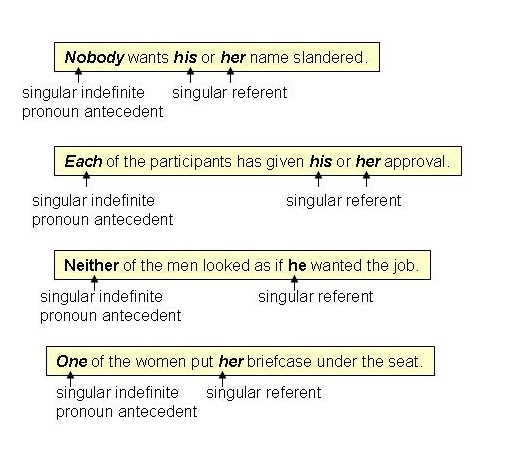
2. The following indefinite pronouns ALWAYS take plural pronoun referents.
![]()
Examples:
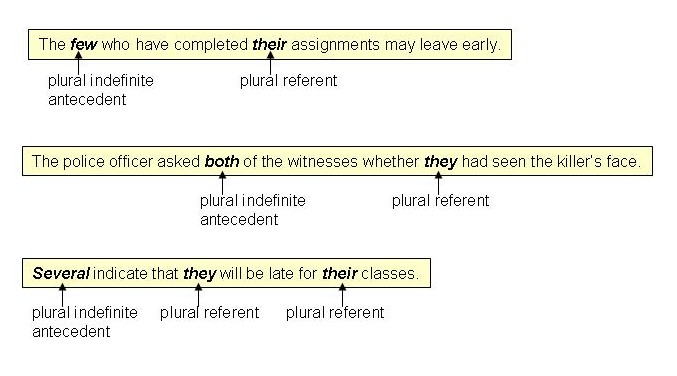
3. However, the following indefinite pronoun antecedents may be either singular or plural, depending upon how they are used in a sentence.

Generally speaking, if one of these indefinite pronouns is used to designate something that CAN be counted, then the pronoun is plural.
If one of these indefinite pronouns is used to designate something that CANNOT be counted, then the pronoun is singular.
Examples:

In the above sentence, all designates the voters. Voters can be counted (1 voter, 2 voters, etc.). Therefore, the plural pronoun their is the correct referent for all.

In the above sentence, all designates sugar. Sugar cannot be counted (1 sugar, 2 sugars). Therefore, the singular pronoun, its, is the correct referent for all.

In the above sentence, all designates some unnamed people (e.g. campers, ranchers). Campers, ranchers – people – CAN be counted. Therefore, the plural pronoun their is the correct referent for all.
You have now reached the end of this unit.
If you are doing this module on your own time, you have completed the learning unit on avoiding problems with pronoun - antecedent agreement.
If you are doing this module as part of your classroom assignment, proceed to the Post Test and follow the directions you find there.
Click on the link below to do the Post Test.